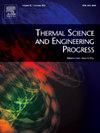Analyzing and optimizing refrigerated hypobaric storage chambers for lime fruit via multiphysics modeling
IF 5.1
3区 工程技术
Q2 ENERGY & FUELS
引用次数: 0
Abstract
Storing fresh produce refrigerated under controlled atmosphere in which the oxygen concentration is reduced, can drastically extend the storability of the product. Within low pressure or hypobaric storage, a controlled atmosphere is created by lowering the total pressure of the air. Previous research on lab-scale has demonstrated significant advantages of hypobaric storage on the quality maintenance of several products. Currently, storage chambers of 750 L are being optimized to apply the technique commercially in a convenient way. However, maintaining uniform temperatures within closed, airtight storage chambers is rather challenging, and quality issues have been encountered during storage because of local hotspots or humidity problems. In this research, the storage of lime fruit inside hypobaric chambers was studied numerically using physics-based modeling. The study sought to 1) understand and analyze the cooling of fruit by mapping the developed temperature gradients inside the chamber, and 2) optimize the design and operation of the chamber to ensure more uniform thermal conditions. At reference storage conditions (30 kPa and 10 °C), temperatures up to 12.5 °C developed inside the chamber. The cooling inside the chamber mainly occurred via conduction. By lowering the storage temperature or operating pressure, the temperature gradients were strongly reduced. To further reduce the temperature heterogeneity within the chamber, additional aluminum plates (“fins”) were introduced within the chamber. Such cooling fins were shown to be effective in lowering the temperature gradients by 70 %. The insights obtained in this study can also be used to optimize the storage of other crops.
利用多物理场模型分析和优化青柠果冷藏箱
在氧气浓度降低的可控气氛下冷藏新鲜农产品,可以大大延长产品的可储存性。在低压或低压储存中,通过降低空气的总压力来创造一个可控的气氛。先前在实验室规模上的研究已经证明了低压储存在几种产品的质量维护方面的显着优势。目前,750升的存储室正在优化,以便以方便的方式将该技术应用于商业。然而,在密闭的储存室内保持均匀的温度是相当具有挑战性的,并且由于局部热点或湿度问题,在储存过程中遇到了质量问题。在本研究中,采用基于物理的建模方法对酸橙果实在低压室内的储存进行了数值研究。本研究旨在1)通过绘制室内温度梯度来了解和分析水果的冷却过程;2)优化室内的设计和操作,以确保更均匀的热条件。在参考储存条件下(30kpa和10°C),室内温度高达12.5°C。腔内的冷却主要通过传导进行。通过降低储存温度或操作压力,温度梯度明显减小。为了进一步降低腔室内的温度不均匀性,在腔室内引入了额外的铝板(“鳍”)。这种冷却翅片被证明可以有效地降低70%的温度梯度。在这项研究中获得的见解也可以用于优化其他作物的储存。
本文章由计算机程序翻译,如有差异,请以英文原文为准。
求助全文
约1分钟内获得全文
求助全文
来源期刊

Thermal Science and Engineering Progress
Chemical Engineering-Fluid Flow and Transfer Processes
CiteScore
7.20
自引率
10.40%
发文量
327
审稿时长
41 days
期刊介绍:
Thermal Science and Engineering Progress (TSEP) publishes original, high-quality research articles that span activities ranging from fundamental scientific research and discussion of the more controversial thermodynamic theories, to developments in thermal engineering that are in many instances examples of the way scientists and engineers are addressing the challenges facing a growing population – smart cities and global warming – maximising thermodynamic efficiencies and minimising all heat losses. It is intended that these will be of current relevance and interest to industry, academia and other practitioners. It is evident that many specialised journals in thermal and, to some extent, in fluid disciplines tend to focus on topics that can be classified as fundamental in nature, or are ‘applied’ and near-market. Thermal Science and Engineering Progress will bridge the gap between these two areas, allowing authors to make an easy choice, should they or a journal editor feel that their papers are ‘out of scope’ when considering other journals. The range of topics covered by Thermal Science and Engineering Progress addresses the rapid rate of development being made in thermal transfer processes as they affect traditional fields, and important growth in the topical research areas of aerospace, thermal biological and medical systems, electronics and nano-technologies, renewable energy systems, food production (including agriculture), and the need to minimise man-made thermal impacts on climate change. Review articles on appropriate topics for TSEP are encouraged, although until TSEP is fully established, these will be limited in number. Before submitting such articles, please contact one of the Editors, or a member of the Editorial Advisory Board with an outline of your proposal and your expertise in the area of your review.
 求助内容:
求助内容: 应助结果提醒方式:
应助结果提醒方式:


